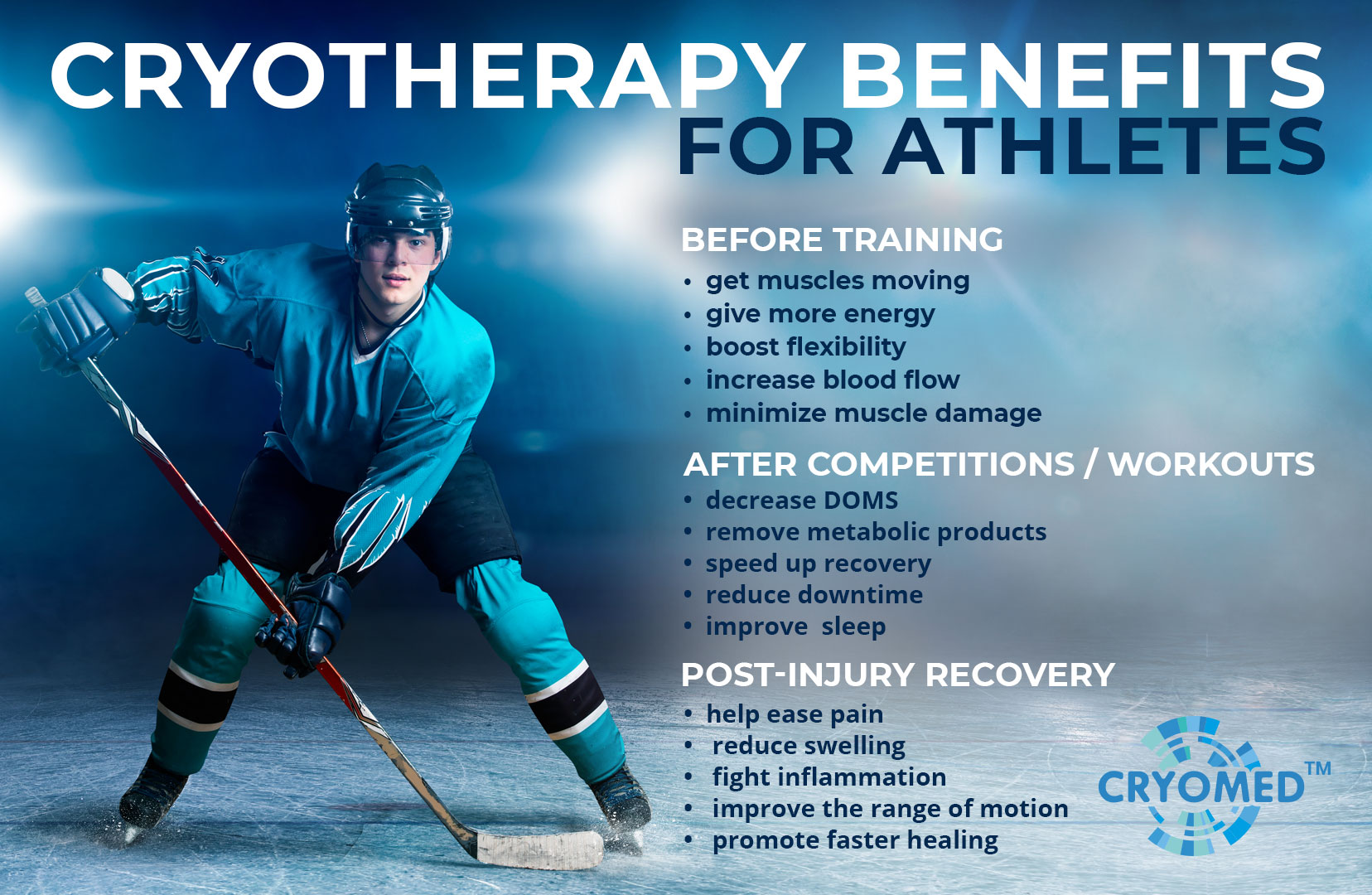Whole-body cryotherapy in health management of hockey players

E.H.C. Alliance partner, Cryomed, explains in this advertorial how super-low temperatures affect the body and offer the best protocols for efficient recovery and enhanced performance for hockey players.
Team coaches, physiotherapists and athletes are always on the lookout for new ways to improve performance, which is especially important in physically and mentally demanding sports like ice hockey. Often, athletes are the first to embrace any new technique that helps them recover faster and play harder.
That’s what happened to whole-body cryotherapy with its treatment temperatures as low as –110°C to –180°C, which became indispensable in training and recovery routines in many top-tier teams, starting from the Oregon Project at Nike in 2010.
Though cold has been traditionally used in sports mainly for recovery, extremely low temperatures demonstrate their efficiency for pre-game or pre-training readiness as well. Over the past decade, scientists thoroughly researched the way extreme cold may benefit athletes, in particular, hockey players.
In broad terms, whole-body cryotherapy can be used for three distinctly different purposes:
Pre-competition or pre-workout treatments to boost performance. Post-exercise recovery to ensure shorter downtime between the games or after a gruelling workout. Post-injury recovery to counter pain, inflammation and encourage faster healing.
Let’s take a closer look at the benefits ultra-low temperatures may bring to hockey players depending on the adopted protocols.

Whole-body cryotherapy for better pre-game or pre-workout readiness
Better performance may stem from:
- Cryotherapy-induced hormonal changes
Whole-body cryotherapy leads to a noticeable burst of testosterone, which serves as a muscle-builder and generates a natural desire to compete, enhancing motivation in training and readiness for competition. Elevated testosterone is associated with reduced pain perception, which is especially valuable for high-performance athletes. WBC diminishes the stress-related cortisol release, which would otherwise impair sports performance. Dopamine, norepinephrine, and epinephrine contribute to a marked reduction in muscular fatigue and better muscular performance. These hormones are also responsible for the psycho-physical stability of an athlete.
- Enhanced blood delivery to muscles
Muscles need energy for action. The body generates aerobic energy through oxidation with oxygen supplied by blood cells. After ultra-cold treatment, the oxygenated blood rushes to the muscles providing “fuel” for active work. Increased muscular perfusion ensures better metabolism, higher muscular flexibility, and lower injury risk.
- Improved cardiovascular performance
Cold exposure reduces resting heart rate and provides for a slower heart rate increase during the exertion period, thus avoiding excessive body core temperature rise. Generally, if less energy is required for cooling the body, extra energy becomes available.
Whole-body cryotherapy for recovery after exercise and competitions
The main effects of extra cold treatment for post-exercise recovery include:
- Oxidant/antioxidant balance support
Among other adverse effects, oxidative stress impairs the oxygen transport function of blood and the regenerative capacity of the muscles. Whole-body cryotherapy counteracts the production of exercise-induced oxidative substances, thus enhancing muscular oxygen supply.
- Reduced inflammation
Though micro-tears and exercise-induced inflammation are an essential part of a strength-building process, they may cause pain and reflexive muscular inactivation, thus resulting in a longer recovery period. Super-cold temperatures stimulate an anti-inflammatory response in athletes by flushing out metabolic products and bringing healing agents like oxygen and other nutrients to the damaged cells.
- Minimization of muscle swelling and soreness
Whole-body cryotherapy is a well-known remedy for counteracting DOMS usually associated with strenuous exercise and overtraining syndrome. Cryotherapy overcomes the limits set by muscle pain and fatigue via reducing lactic acid generation, loosening tight or sore muscles, enhancing muscle oxygenation, and thus promoting muscle function and flexibility.
- Increased energy intake
Post-exercise WBC treatment is suitable for hockey players because it reportedly increases post-activity energy intake vital for proper muscle recovery and attenuation of exercise-induced muscle damage.
- Restful sleep
Any hockey team manager, coach, or physiotherapist will tell you that adequate rest is crucial for a hockey player’s recovery. After strenuous exercise and stressful competitions, it is often hard to fall asleep or have a deep and restful sleep. Fortunately, cryotherapy counters sleep disorders through relieving stress, controlling anxiety, enhancing blood supply, and generally rebooting body and mind.
To summarize, during the active season, whole-body cryotherapy may be used both before and after the event, while during off-season training, extra cold treatments after workouts may hamper muscular strength building. Therefore, it is recommended to use cryo applications only before training for better muscle performance.
Whole-body cryotherapy for post-injury recovery
Muscle-related injuries, as well as ankle and knee swelling, pain, sprains, and strains, are common for hockey. Whole-body cryotherapy may significantly shorten convalescence and prevent the condition from becoming chronic, especially in conjunction with spot treatments.
Below zero therapy may be applied to:
- Alleviate pain;
- Counteract inflammation;
- Reduce swelling in joints, soft tissues, and muscles;
- Overcome restriction in muscles and joints mobility;
- Reduce the periods away from training.
There is one more notable effect – cryotherapy helps the bone tissue regenerate faster. That means that serialized whole-body cold exposures may facilitate injured bone healing and prevent fatigue fractures, which happen with little or no symptoms.
All of the above benefits show the potential of whole-body cryotherapy not only for recovery but also for athletes’ passive warm-up along with other traditionally involved passive and active warm-up elements before competitive activities and in-between the matches or workouts.
Check out a video interview with one of Cryomed’s customers, HC Košice:
Cryomed Manufacture s.r.o., a Slovak producer of whole-body and local cryotherapy equipment since 2002, developed an online training course for team doctors and physiotherapists on cryotherapy applications in modern sports based on available scientific research. The course provides in-depth understanding of the ways super-low temperatures affect the body and offers the best protocols for efficient recovery and enhanced performance. If you are interested in getting access to the course, please contact Ms. Olena Sydorenko at info@cryomedpro.com.









